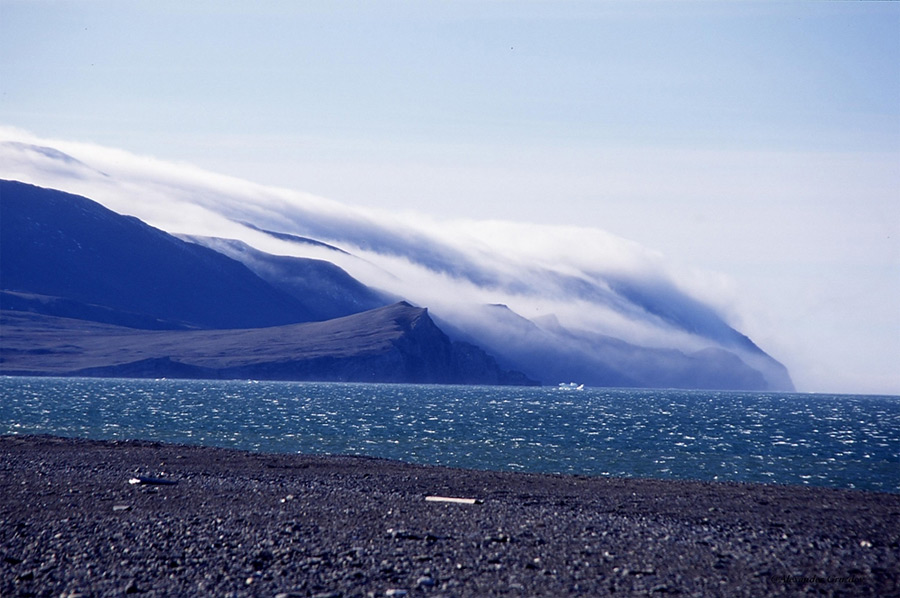 |
| Polar bears feasting on a whale carcass on Russia's Wrangel Island in the Arctic Circle. |
Bears are generally solitary animals and normally keep a safe distance from one another, except during the mating season. However, when they are seen congregating in large numbers in a particular area, it might imply that they are social animals when in fact they are not. This example is best seen in the case of grizzly bears and Alaskan brown bears, which are known to congregate in large numbers during the annual spawning of salmon in North America. Although it initially appears that these bears are socializing over salmon, many keep their distance to avoid conflict with one another. But even with millions of fish to choose from, there is always a chance of conflict when the bears compete with one another for food to satisfy their immense appetites. The only social interaction that occurs during such events is between mother bears and their young. That is, the mothers teach their cubs how to fish for their food and most importantly, avoid contact with the highly competitive and dangerous male bears.
 |
| Some 200 bears gathered on the island, which scientists see as a sign of Arctic changing. |
But two months ago, in the far eastern side of the Russian Arctic, a similar event occurred in which polar bears were sighted by a boatload of tourists congregating in large numbers on Wrangel Island. According to Alexander Gruzdev, director of the Wrangel Island nature reserve, the bears were seen feasting on a bowhead whale carcass that had washed ashore and later resting around it. While this encounter may seemed like a spectacle for the tourists, scientists see it as an indication of the effect of climate change on the polar bears. Due to the melting of ice earlier this year, the bears are forced to spend longer time on land than on ice where they are most at home. In addition, the bears will sooner or later face competition for little food there is on land the more crammed together they are on coasts and islands. Wrangel Island is known to be a resting place for polar bears after ice melts in early August until November, when they leave the island to hunt for seals. Mr. Gruzdev added that it is also known to have the "highest density of maternity dens in the entire Arctic." However, according to Eric Regehr from University of Washington and the lead scientist on the U.S-Russian collaborative study of Wrangel Island's polar bears, the animals now spend on average a month longer on the island, compared to how they did 20 years ago. Studies have also shown that the number of bears discovered this autumn was 589, far surpassing previous estimates of 200-300 animals which Mr. Regehr calls "anomalously high."
 |
| Coastal landscape of Wrangel Island |
I really think that the public should recognize this sighting as an indication of the climate change's effects on not just polar bears, but also other inhabitants in the Arctic Circle. Not only is the melting of ice forcing the bears to spend more time on land than on ice, but it is also compelling them to venture close into villages putting locals at risk. Since mid-October, the bears have been coming dangerously close to a Chukchi village called Ryrkaipy near Kozhevnikov Cape which is located 124 miles south of Wrangel Island. Kozhevnikov Cape also happens to be an important site for walrus congregations known as haulouts. Due to change in ice conditions, walruses are forced to come ashore in steep inadequate areas. According to polar bear specialist Viktor Nikiforov, hundreds of walruses died this year as huge individuals crushed one another probably after being disturbed by a predator. The incident resulted in some walrus carcasses floating to the village, thus attracting polar bears. This was seen when one bear broke a window of a house, sending the entire village to go on high alert. Mr. Nikiforov added that scientists and local people moved walrus carcasses away from the village with bulldozers and reiterated concerns that bears spend more time ashore than on ice. He further added that measurements such as bear patrols need to be implemented to reduce human-bear conflicts.
 |
| Climate change is also forcing walruses to come ashore in unsuitable areas. |
I also feel that because polar bears are spending more time on land than on ice, they are unable to hunt for seals the way they used to decades ago. Despite having some food sources on land such as lemmings, musk oxen, or even grass, the bears solely rely on seals as their main source of energy-packed food which they have evolved to depend on. This also explains why hundreds of bears gathered around the whale carcass on Wrangel Island. Like seals, whales are also packed with energy which polar bears rely on. This is why they often target beluga whales, as well as seals and walruses, while hunting on ice. The impact of climate change appears to have tremendously influenced the behavior of polar bears. They are spending more time on land in larger concentrations than they are on ice and they are forced to move dangerously close to human settlements increasing the chance of human-bear conflict. This is why it is highly essential to consider the effects of climate change seriously and take necessary action to prevent any devastation of both people and wildlife.
View article here
No comments:
Post a Comment